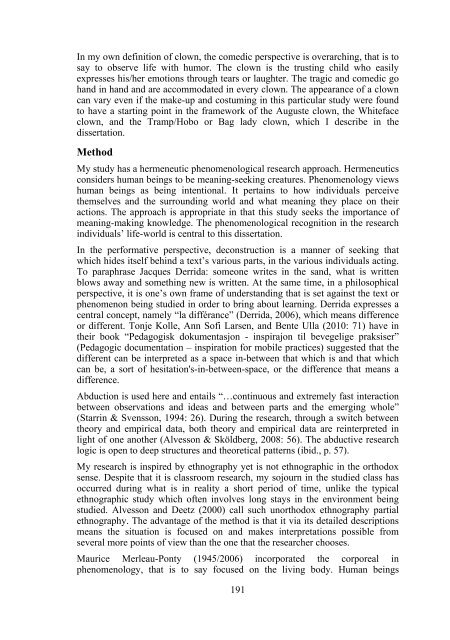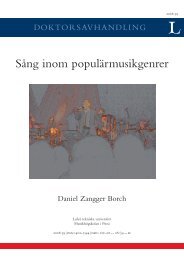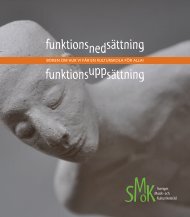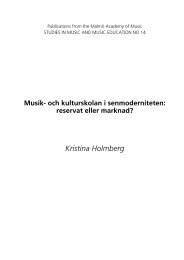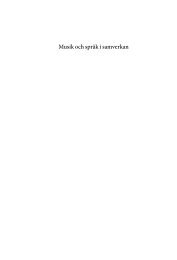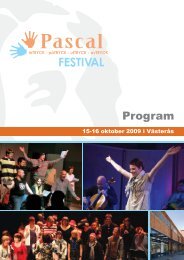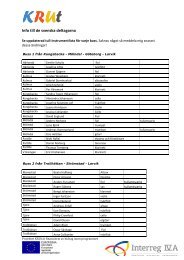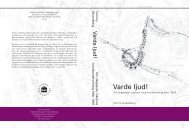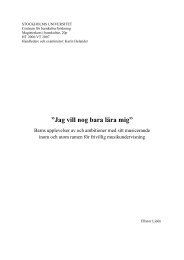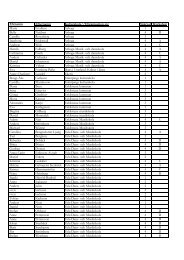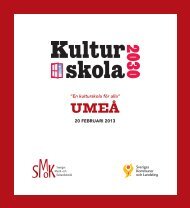KARNEVAL I KLASSRUM âKUNSKAP PÃ HJUL
KARNEVAL I KLASSRUM âKUNSKAP PÃ HJUL
KARNEVAL I KLASSRUM âKUNSKAP PÃ HJUL
Create successful ePaper yourself
Turn your PDF publications into a flip-book with our unique Google optimized e-Paper software.
In my own definition of clown, the comedic perspective is overarching, that is to<br />
say to observe life with humor. The clown is the trusting child who easily<br />
expresses his/her emotions through tears or laughter. The tragic and comedic go<br />
hand in hand and are accommodated in every clown. The appearance of a clown<br />
can vary even if the make-up and costuming in this particular study were found<br />
to have a starting point in the framework of the Auguste clown, the Whiteface<br />
clown, and the Tramp/Hobo or Bag lady clown, which I describe in the<br />
dissertation.<br />
Method<br />
My study has a hermeneutic phenomenological research approach. Hermeneutics<br />
considers human beings to be meaning-seeking creatures. Phenomenology views<br />
human beings as being intentional. It pertains to how individuals perceive<br />
themselves and the surrounding world and what meaning they place on their<br />
actions. The approach is appropriate in that this study seeks the importance of<br />
meaning-making knowledge. The phenomenological recognition in the research<br />
individuals’ life-world is central to this dissertation.<br />
In the performative perspective, deconstruction is a manner of seeking that<br />
which hides itself behind a text’s various parts, in the various individuals acting.<br />
To paraphrase Jacques Derrida: someone writes in the sand, what is written<br />
blows away and something new is written. At the same time, in a philosophical<br />
perspective, it is one’s own frame of understanding that is set against the text or<br />
phenomenon being studied in order to bring about learning. Derrida expresses a<br />
central concept, namely “la différance” (Derrida, 2006), which means difference<br />
or different. Tonje Kolle, Ann Sofi Larsen, and Bente Ulla (2010: 71) have in<br />
their book “Pedagogisk dokumentasjon - inspirajon til bevegelige praksiser”<br />
(Pedagogic documentation – inspiration for mobile practices) suggested that the<br />
different can be interpreted as a space in-between that which is and that which<br />
can be, a sort of hesitation's-in-between-space, or the difference that means a<br />
difference.<br />
Abduction is used here and entails “…continuous and extremely fast interaction<br />
between observations and ideas and between parts and the emerging whole”<br />
(Starrin & Svensson, 1994: 26). During the research, through a switch between<br />
theory and empirical data, both theory and empirical data are reinterpreted in<br />
light of one another (Alvesson & Sköldberg, 2008: 56). The abductive research<br />
logic is open to deep structures and theoretical patterns (ibid., p. 57).<br />
My research is inspired by ethnography yet is not ethnographic in the orthodox<br />
sense. Despite that it is classroom research, my sojourn in the studied class has<br />
occurred during what is in reality a short period of time, unlike the typical<br />
ethnographic study which often involves long stays in the environment being<br />
studied. Alvesson and Deetz (2000) call such unorthodox ethnography partial<br />
ethnography. The advantage of the method is that it via its detailed descriptions<br />
means the situation is focused on and makes interpretations possible from<br />
several more points of view than the one that the researcher chooses.<br />
Maurice Merleau-Ponty (1945/2006) incorporated the corporeal in<br />
phenomenology, that is to say focused on the living body. Human beings<br />
191


